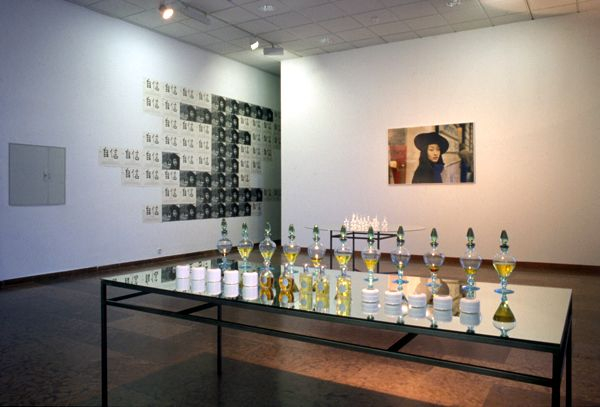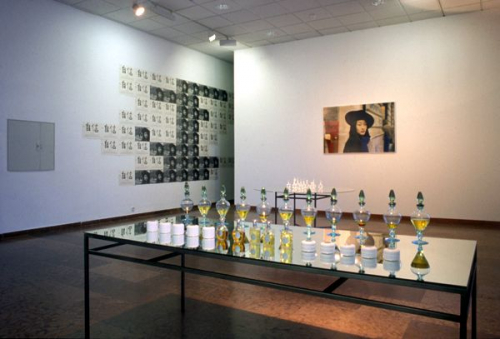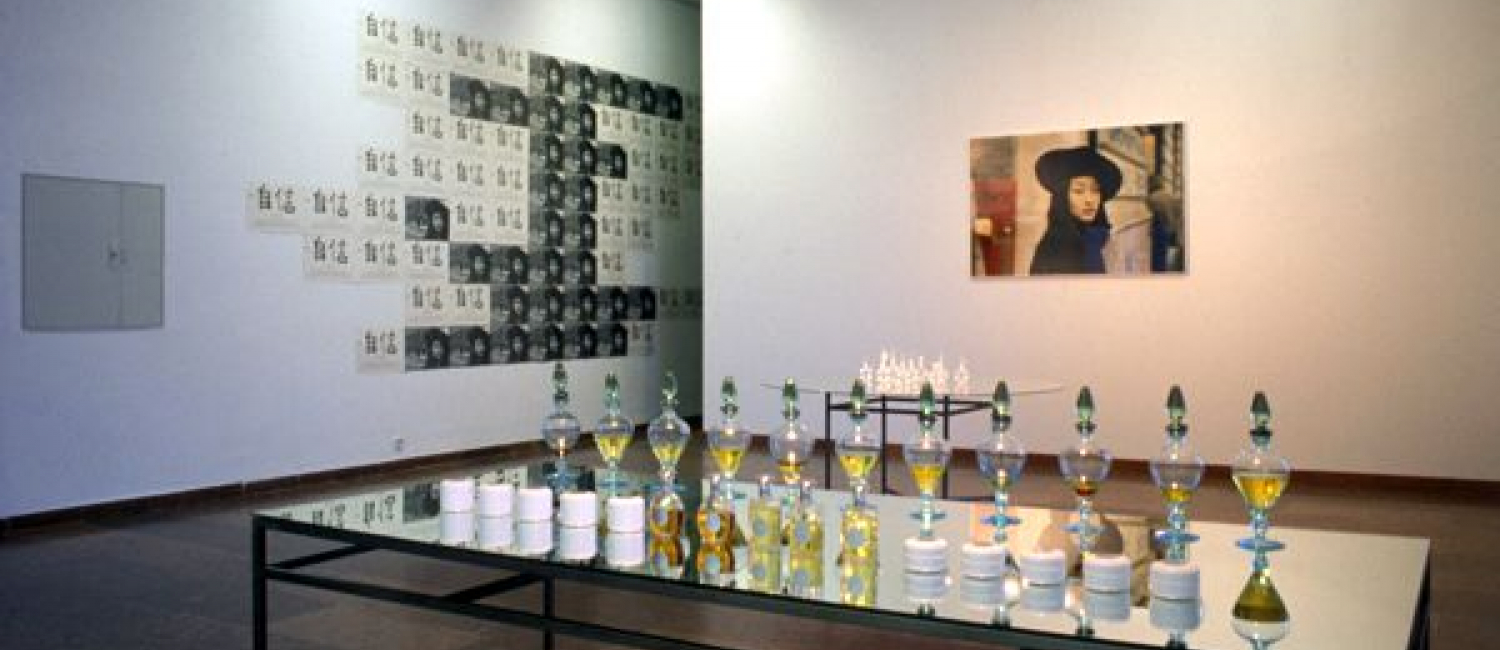Orshi Drozdik is one of the few Hungarian artists who have achieved international reputation. She began her career in Budapest, after a promising start and success, she rather chose to participate in the international art scene when she moved in 1978 to Amsterdam, and then in 1980 to New York. On these two stages, an extremely rich and manifold oeuvre evolved. She regularly exhibited in New York galleries (Tom Culiagni, Richard Anderson, Andrea Rosen) and museums (the Alternative Museum, New Museum of Contemporary Art), and participates in large-scale international events (São Paolo Biennial, Sydney Biennial). Her works can be found in the collections of the Museum Moderner Kunst (Vienna) and the Ludwig Museum Budapest – Museum of Contemporary Art. Since the political changes of 1989 in Hungary, she frequently returns and exhibits in Hungary (Mûcsarnok/Kunsthalle Budapest, Ernst Museum, Knoll Gallery), as well as she presents lectures primarily on gender issues in art at different Colleges of Art and at conferences. In 1999 she edited a collection of essays on psychoanalytical feminism, entitled Sétáló agyak (Walking Brains) in Hungarian. Her work, both as an artistic and a theoretical role-model, have made a stimulating impact on the Hungarian art scene and on the shift in paradigm in art, as well as on numerous young artists.
Her work, based upon post-structuralist philosophies, on the deconstructivist theories of Foucault and Lacan and on post-feminism, has been part of the international discourse of the eighties and nineties. She works in various genres in parallel: from the very outset, she has been drawing, painting, photographing and producing objects and installations from the most diverse types of materials: from glass, porcelain, rubber, metal. In her works she consistently applies the female perspective. Individual works are created over the course of several years or even decades, and they constitute series building upon or complementing one another; these can be divided into two larger groups. In her analytical works, on the one hand, she examines woman’s identity, the ways and process of the construction of the female body in patriarchal society; on the other hand, through her continuing research she deconstructs science by showing its role in the formation of gender roles. As opposed to the modernist myths of the bipolar, essential gender identity and objectivity of science through her conceptual works she reveals their constructed nature.
Drozdik’s works produced during her years at the academy questioned the normative traditional artistic canon and avantgarde strategy, as well as the possibilities and limits of female role-models – in an artistic milieu for which the raising of such questions was practically unheard of – and which remained so for some time to come. In her photographic series entitled Individual Mythology (1976), employing the female role-models of free dance – taking as her starting point photographs preserving the gestures of Isadora Duncan, among others – she plays the role of a woman artist (female dancer). In her 1977 performance, on exhibition titled Nudes, she explores the artistic presentation of the female body allegedly representing universal values but actually in accordance with male values, in this respect she was the forerunner of the international trend that emerged in the eighties. Stepping out of the passive role (object), as an active artist (subject), as the object of her depiction - and of male desire – she takes upon herself the role of the nude model and raises the problem of the male gaze upon the female body. The move to New York opened a new chapter in Drozdik’s art. The conceptual, minimalist character of her early work came to be replaced by a systematic, analytical, creative, and at the same time, critical research method. She concerned herself with the human body, as well as the traditional dichotomy of nature and culture, from the perspective of scientific representation. Through the deconstruction of a discourse commonly viewed as objective, she presents this process that goes back to the age of the enlightenment, and according to which human relations or features were classified into a strict hierarchical order, glorifying certain elements, while discriminating or denying others; this hierarchical order was later considered axiomatic and was to determine our way of thinking, concepts and identity for a long time.
Her photographic series, Distopium Infinite has probably been Drozdik’s boldest adventure in scientific fields: since 1983 until today, she has been photographing objects displayed in medical and technological museums. Her method of changing perspective and placing things in new contexts culminated in the pseudo-persona of the scientist Edith Simpson: Drozdik thus introduced the female viewpoint into a basically patriarchic context. She invents not only a biography for her fictitious female pseudo-scientist, but she also creates pseudo-instruments, and attempts to break through the authoritative coldness of these objects with love letters. With writing the letters she appropriates the (patriarchic) language, and queries the male viewpoint. In the exhibition, alongside these photos, installations, Adventure in Technos Dystopium, Natural Philosophy (1988), Fragmenta Naturae (1989), Metamorphosis (1990), The Sexual System of Plants (1990) and Cynical Reason (1991) represent Drozdik’s assemblage of artworks.
The series of works begun in the nineties under the title of Manufacturing the Self constitutes the third part of the exhibition. Placing herself within various cultural, historical and geographical contexts, Drozdik here investigates the ways in which the self-image and, within this, female identity is shaped (constructed). The investigations carried out in scientific and medical museums are brought further in the installation entitled Manufacturing the Self: The Body Self. The central element of the work is a rubber-cast model of the artist’s body, inspired by Clemente Susini’s Medical-dummies from the 18th century. Drozdik defines one of her body-selves by showing the female body, waiting to be dissected (from the 18th century onwards, medical models were increasingly dissection demonstration models), and exposed to the male gaze. The sculpture, lying on the (dissection) table, is surrounded by black-and-white photographs of wax figures used for studying pathology. The photos are arranged as a filmstrip, as if they were showing stages of the autopsy from various angles. The female corpse - a reclining nude, this impersonal and passive, defenceless object, is brought to life by Drozdik, who places her love letters engraved in silver plates around her. With consternation, the viewer realizes a passionate relationship through the confessions, the love letters of the woman waiting to be dissected. The “object”, damned to muteness, now utters to speak—in her own voice, in her own words. Thus, the coherence of the role of the speechless scientist examining reality with objective methods is broken, and it becomes obvious that other perspectives exist outside of the one that was deemed absolute. In the love letters written to the Leyden Jar, or those of the Normal and Pathalogical (1995) installation, the female voice is highly passionate, as opposed to the cool, objective male rationality.
The exhibition presents works selected from the past 25 years, including early photographs, paintings, painting-installations, a photo-series begun in the 1980s, installations related to science and finally, works from the 1990s dealing with female identity. Beyond revealing the complexity of her thematics, we would like to expose the innovative attitude by which Orshi Drozdik combines the most divergent of genres, expanding, for example, the possibilities offered by sculpture with those of texts considered as sculptures.
Curators of the exhibition: Dóra Hegyi and Franciska Zólyom


